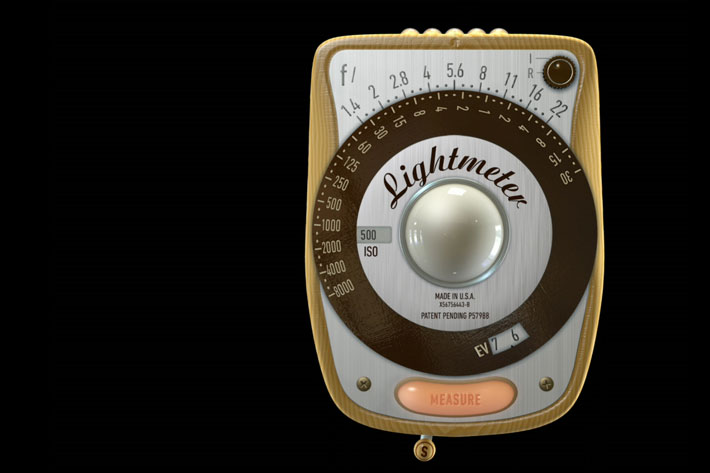
LightMeter for Android or myLightMeter for iOS are different names for an app that will transform your smartphone in a reliable light meter. There is a free version, but the Pro will give you some extras.
If you’re old enough to remember the classic light meters from the past, you’ll love the retro style of the Lightmeter app created by David Quiles for both Android and iOS. The market is packed with modern looking apps that reflect the present, but this light meter transports us, visually, to the past. Although it is just the effect of a simple interface image showing on the screen of your smartphone, sometimes you almost imagine the sensation of touching the controls of the old-style device, despite the fact that what you’re really holding on your hand is a smartphone. When you pick the phone to meter light, and those around you see the app you’re using, they will probably say: “I want one of those, too”.
The app was created, says the author, “for real old school photographers or advanced amateurs shooting analog photography” who may need to measure light, but nothing stops you, even if you have a modern camera with a built-in light meter and never saw an old light meter to download the app, either the LightMeter for Android or myLightMeter for iOS, and try it, for the simple fun of discovering how it works. And who knows, you might want to use a camera without a meter, and this one, according to the reviews from different users, is efficient enough to be used instead of a classic light meter.
As any application made for smartphones, the results you get will depend on the smartphone used, and that explains why some users are happier than others: for some it worked right out of the box, offering readings similar to Sekonic or Gossen light meters, while others had to calibrate the app, which in fact is only possible on the paid version.
The author always gives the first version for free without limitations, but, as expected, improvements, new features and users’ requests are only made for the paid version, which costs $3.99 for the myLightMeter Pro, for iOS and $1.99 for the LightMeter (noAds) for Android. David Quiles says that “for the price of a soda you will support hundreds of hours of work and will get more features and improvements.”
LightMeter (I’ll refer to the Android version, which I’ve installed) offers both incident and reflected light metering. The first works on any device, but David Quiles suggests the use of reflected light, which offers better precision. Again, the paid version allows you not only to calibrate the device for your smartphone, with independent calibration for each metering mode, it also allows to save settings between uses, features not available on the free version.
One note for iOS users of the app: accurate incident light reading needs a diffuser attached to the front camera. Without the diffuser the app can be used but it will be a reflected reading taken with the front camera.
Requests from users have also been included in updates. The incident light reading can be held on the paid version, which also offers an alternative ISO selector, a feature requested by users who had difficulty to see the small numbers in the ISO settings window. Apple users do pay more for the app, but the iOS version offers more features, like independent selection of aperture, speed, ISO and exposure compensation with 1/3 resolution. From 4 minutes to 1/8000 sec., aperture from 1.0 to 512 and the same ISO, from 3 to 6400.
With two different interface designs, automatic ISO or locked ISO options, memory for 5 lenses with maximum aperture, focal length and film/sensor size for calculating hyperfocal distance and aperture, hyperfocal distance also for infrared light and exposure value EV on an analog scale or right up front as some other features present on the iOS version, the myLightMeter Pro is a more complete version, which fully justifies the extra cost. The features present expand the potential of the light meter as a tool to teach others about lighting and exposure.
Feedback from users has helped the author to define what to implement in new versions of the program, and the suggestions for other features, like flash metering, are present on recent comments published. Photographers continue to discover the app, and pass along the information and their opinions about it, and the evolution of the iOS version does suggest the author has updated it more regularly than the Android version, and integrated more features.
As an Android user of the app, I would not mind paying extra to have the features present on the iOS version, even through an upgrade, but I believe that’s not going to happen, because, as David Quiles says on his Android page for the free app, “currently I’m getting support from 0.016% of the users”, meaning that most users will just use the free version – even if they complain about its limitations – and are not willing to spend the two dollars asked, or a bit more for an eventual expanded version, to support the author. That’s, I believe, the problem with many apps available today. Just remember, though, that a normal light meter will cost you much more…
